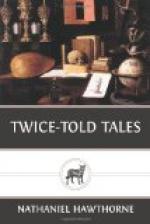The mother and daughter talked a long while with Mr. Wigglesworth about a suitable epitaph, and finally chose an ordinary verse of ill-matched rhymes which had already been inscribed upon innumerable tombstones. But when we ridicule the triteness of monumental verses, we forget that Sorrow reads far deeper in them than we can, and finds a profound and individual purport in what seems so vague and inexpressive unless interpreted by her. She makes the epitaph anew, though the selfsame words may have served for a thousand graves.
“And yet,” said I afterward to Mr. Wigglesworth, “they might have made a better choice than this. While you were discussing the subject I was struck by at least a dozen simple and natural expressions from the lips of both mother and daughter. One of these would have formed an inscription equally original and appropriate.”
“No, no!” replied the sculptor, shaking his head; “there is a good deal of comfort to be gathered from these little old scraps of poetry, and so I always recommend them in preference to any new-fangled ones. And somehow they seem to stretch to suit a great grief and shrink to fit a small one.”
It was not seldom that ludicrous images were excited by what took place between Mr. Wigglesworth and his customers. A shrewd gentlewoman who kept a tavern in the town was anxious to obtain two or three gravestones for the deceased members of her family, and to pay for these solemn commodities by taking the sculptor to board. Hereupon a fantasy arose in my mind of good Mr. Wigglesworth sitting down to dinner at a broad, flat tombstone carving one of his own plump little marble cherubs, gnawing a pair of crossbones and drinking out of a hollow death’s-head or perhaps a lachrymatory vase or sepulchral urn, while his hostess’s dead children waited on him at the ghastly banquet. On communicating this nonsensical picture to the old man he laughed heartily and pronounced my humor to be of the right sort.
“I have lived at such a table all my days,” said he, “and eaten no small quantity of slate and marble.”
“Hard fare,” rejoined I, smiling, “but you seemed to have found it excellent of digestion, too.”
A man of fifty or thereabouts with a harsh, unpleasant countenance ordered a stone for the grave of his bitter enemy, with whom he had waged warfare half a lifetime, to their mutual misery and ruin. The secret of this phenomenon was that hatred had become the sustenance and enjoyment of the poor wretch’s soul; it had supplied the place of all kindly affections; it had been really a bond of sympathy between himself and the man who shared the passion; and when its object died, the unappeasable foe was the only mourner for the dead. He expressed a purpose of being buried side by side with his enemy.
“I doubt whether their dust will mingle,” remarked the old sculptor to me; for often there was an earthliness in his conceptions.




